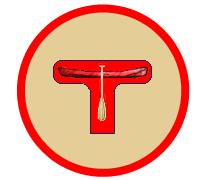


Pros:
Cons:

Pros:
Cons:
I've never used a hammock tent but have always wanted to. I've talked to people who have used them and they seem to like them but they do have a big disadvantage when the weather turns. Gear has to be stored outside and changing clothes, etc. is outside for the most part. Not a problem in nice weather but I can see it being a nuisance in rain. And sometimes it isn't as easy as you might think to find two convenient trees to hang it between.
If you are considering buying a hammock tent the following comments from a friend who has a hammock tent might help you in your decision.
Personally I would go with Hennessy Hammocks. I purchased mine online and it was at my door in days. Also, I have had good luck with their service department regarding warranty issues with the rainfly. You can find them at: Hennessy Hammock.
Hennessy has two basic types of hammocks:
- The Asym Classic (enter through the bottom)
- The Asym Zip (zipper side entry)
I have the Hennessy Explorer Ultralite A-Sym ZIP Hammock which I find much roomer than the classic version. The side entry zipper is great because you can pull back the bug mesh during the day and use hammock like a regular open hammock. For the classic model, you must come in from the bottom and there is far less room to move around. There are different models for different weight people. Personally I like the longer hammock and the extra weight of the hammock doesn't bother me.
Go with the Hennessy Hex Rainfly 70D Polyester.... It is a little heavier and cheaper than the 30D Silnylon material. The Silnylon is too light in my opinion and I have gone through a couple of replacements due to rip / seam failures.
I have purchased various length tree hugger's over and above what came with the hammock so that there are some for small diameter tree trunks and some for larger diameter tree trunks.
Hammocks can be winterized by purchasing insulated pads from the manufacturers. They would work okay for winter.... BUT you still must get in and out of the hammock and there is no place to put your boots but on the ground below the hammock. At least a tent offers you a place to put your boots that won't be as exposed. The same kind of problem occurs with your clothing. You can push your clothing you are wearing to one end of the hammock. However using a tent allows you to put all your clothing inside with space to spare. For people with hammocks, you pretty much store all things that you need to keep dry in your backpack.
Personally, I only use my hammock for the warmer months of the year. However, I have bumped into people who exclusively use their hammocks for spring, summer and fall. Of course the big advantage of a hammock is that you can set them up pretty much any where as long as there is two trees about 14 to 16 feet apart.... even set them up over big rocks.
Picking hammock campsites can sometimes be tricky especially on open sites that have a lot more by way of tent pads... You almost have to go further back into the bush to find suitable trees at the proper distance apart. However, for all the years I've been using a hammock, I find that I can usually find a great hammock site on very uneven ground where you would not think of putting a tent with ease.
With my side entry hammock, you can get into the hammock and into your sleeping bag easier than the hammocks where you come in from the underside. The other thing that you must keep in mind is that when you get into a side entry hammock things have a tendency of coming out when you are going in. It is a bit of a balancing act to keep your sleeping pad, sleeping bag, sleeping bag, toilet paper etc. from coming out as your getting in as the weight of your body pulls the opening down and things will roll out.